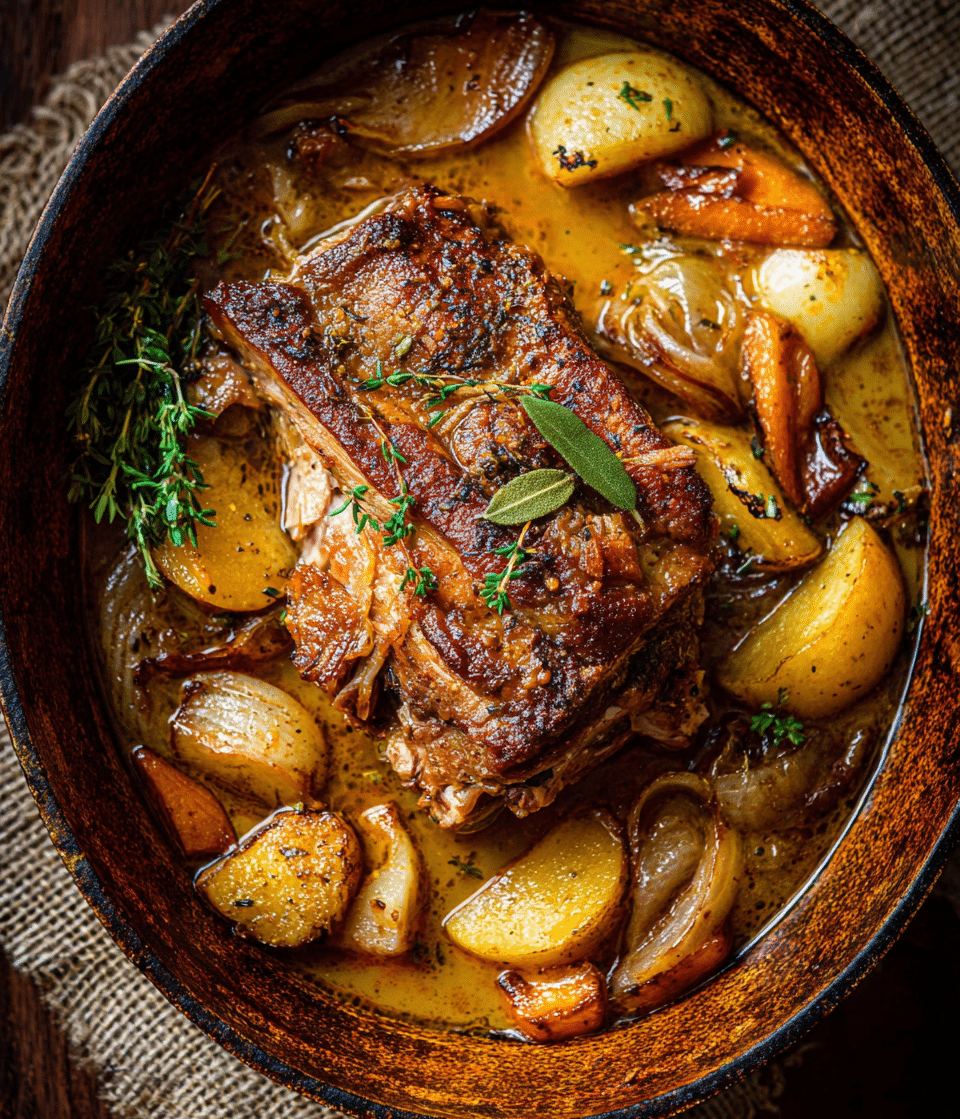Why Choose Pork Shoulder?
Pork shoulder is an ideal cut for braising because of its natural tenderness and the way it holds up to slow cooking. Unlike leaner cuts like pork loin, pork shoulder contains a good amount of fat and connective tissue that break down during braising, resulting in a juicy and flavorful piece of meat. This makes it perfect for dishes like pulled pork, stews, and roasts, where slow cooking can work its magic.
The fat content in pork shoulder helps keep the meat moist during the braising process. As it cooks, the fat melts into the meat, enhancing its richness and tenderness. This is especially important when cooking low and slow, as it ensures that the pork won’t dry out but will remain juicy and succulent. Whether you choose a bone-in or boneless cut, the results will be impressive, as the slow cooking method ensures a melt-in-your-mouth experience.
The Role of Apple Cider in the Recipe
Apple cider plays a central role in this dish, contributing both tang and sweetness that perfectly balance the savory richness of the pork. The natural sugars in the cider caramelize during cooking, creating a rich, flavorful braising liquid. The acidity of apple cider also helps to tenderize the pork, enhancing its texture and flavor. The cider creates a depth of flavor that pairs wonderfully with the Dijon mustard and herbs.
When selecting apple cider, it’s important to use fresh, unfiltered cider, as this will provide a more robust, fruity flavor compared to filtered or vinegar-based apple cider. The use of apple cider in savory dishes like this one is a common technique in many fall and winter recipes, as it complements the richness of meats like pork, chicken, and even beef. The slight sweetness of the cider adds a layer of complexity that makes the braised pork feel indulgent yet comforting.
The Role of Herbs and Aromatics
In addition to the apple cider, this recipe calls for fresh herbs like rosemary and thyme, along with garlic and dehydrated onion. These ingredients bring an aromatic depth that enhances the flavor profile of the pork. Herbs like rosemary and thyme are well-suited for long, slow cooking, as their robust flavors infuse the braising liquid, giving the dish a fragrant, herbal undertone that complements the pork beautifully.
Garlic adds a mellow, sweet flavor when roasted along with the pork, while dehydrated onion contributes a subtle, savory sweetness to the dish. The garlic cloves soften as they cook, becoming tender and sweet, and when squeezed from their skins, they add a delicious depth to the braising liquid. These aromatics not only enhance the flavor but also create a mouthwatering fragrance that fills the kitchen as the pork braises.
Why Apples and Onions Are the Perfect Accompaniments
Adding apples and onions to the dish halfway through the braising process enhances both the flavor and the texture of the finished dish. The apples break down slightly as they cook, becoming tender and slightly caramelized, which adds a delightful sweetness that balances the richness of the pork. The tartness of the apples—particularly varieties like Honeycrisp or Pink Lady—also adds a bit of brightness to the dish, cutting through the richness of the pork and adding complexity to the overall flavor profile.
Onions, when braised in the same liquid as the pork, soften and become sweet, developing a rich, savory flavor that complements the pork and apples. The sweetness of the caramelized onions, combined with the tanginess of the apples, creates a beautiful balance that elevates the dish.
Pairing with Sides
Apple cider braised pork shoulder is a dish that pairs wonderfully with a variety of sides. The rich, flavorful braising liquid makes a perfect sauce to spoon over mashed potatoes, spaetzle, or any other hearty starch. The creamy mashed potatoes soak up the delicious juices from the pork, creating a comforting, flavorful base for the dish. Spaetzle, a type of German dumpling, is another excellent choice, as it absorbs the braising liquid and pairs perfectly with the tender pork.
For a lighter side, you can serve the braised pork with roasted vegetables like carrots, parsnips, or Brussels sprouts. These vegetables, when roasted until caramelized, add a slightly sweet and earthy contrast to the pork. A simple green salad with a tangy vinaigrette can also help cut through the richness of the dish, providing a refreshing balance.
Storing and Reheating Leftovers
One of the great advantages of this dish is that it makes excellent leftovers. The flavors only improve as the pork rests in the braising liquid, making it even more delicious the next day. To store leftovers, allow the pork to cool to room temperature before transferring it to an airtight container. The pork can be stored in the refrigerator for up to 3–4 days. If you want to store it for a longer period, you can freeze the braised pork for up to 3 months.
When reheating, be sure to gently warm the pork in its braising liquid. This will help to maintain its tenderness and juiciness. You can reheat the dish in a slow cooker, on the stovetop, or in the oven. If reheating in the oven, cover the dish with foil to prevent it from drying out, and cook at a low temperature (around 300°F) until the pork is heated through.
The Nutritional Benefits of Apple Cider Braised Pork Shoulder
While this dish is certainly indulgent, it also provides a number of nutritional benefits. Pork shoulder is a good source of protein, which is essential for muscle repair and growth. It also provides important vitamins and minerals like vitamin B12, zinc, and iron. The apples in the dish offer a healthy dose of fiber, vitamin C, and antioxidants, which can help boost your immune system and promote digestive health. The braising liquid, made with apple cider and chicken broth, adds flavor without overwhelming the dish with unnecessary calories or fat.
Of course, like all rich comfort foods, this dish should be enjoyed in moderation. While it provides a hearty serving of nutrients, it also contains a fair amount of fat and sodium, so it’s important to balance this meal with lighter options throughout the rest of the day.
Conclusion
Apple cider braised pork shoulder is the perfect dish for those who love a comforting, rich meal with a balance of savory, sweet, and tangy flavors. Whether you’re preparing it for a cozy autumn dinner or serving it at a family gathering, this recipe is sure to impress. The slow braising method results in a tender, flavorful pork shoulder that is complemented by the sweetness of apples, the savoriness of onions, and the depth of fresh herbs and garlic. It’s a dish that feels both indulgent and wholesome, making it the perfect choice for any occasion. Enjoy it with your favorite sides, and savor the delicious flavors that come with every bite.






